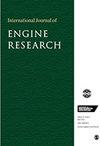由辉光塞辅助的甲醇压缩点火发动机的计算研究
IF 2.1
4区 工程技术
Q2 ENGINEERING, MECHANICAL
引用次数: 0
摘要
这项研究探讨了在辉光塞(GP)辅助下在轻型柴油发动机中燃烧纯甲醇的可行性。模拟的发动机负荷较轻,平均有效压力为 7 巴。研究进行了广泛的计算研究,并证明了纯甲醇压燃发动机的成功运行。研究评估了 GP 位置、喷射伞角度、辉光塞与喷射轨迹之间的相对角度 (RA) 以及喷射策略对发动机性能的影响。研究发现,甲醇-空气混合物的自燃主要发生在等效比为 0.2 和 0.4 之间时。然而,由于蒸发吸热强烈,更浓的混合气伴随着更低的温度,大大延长了点火延迟时间。因此,为了改善点火和燃烧放热过程,对 RA 进行了优化,以充分控制 GP 周围的混合气分布。在 GP 的每个位置,由于燃烧室内复杂的流动和空气燃料混合,最佳 RA 都有所不同,当 GP 从进气口逆时针移动到排气口区域时,最佳 RA 变小(从 12.5° 减小到 5°)。此外,还提出了一种分喷射策略,以确保甲醇射流的成功点火。发动机性能对先导和主喷射时间的敏感度很高。建议采用不高于 20% 的小先导质量分数,以减轻燃料喷射与 GP 的相互作用以及压扁区域的燃料撞击。本文章由计算机程序翻译,如有差异,请以英文原文为准。
Computational investigation of a methanol compression ignition engine assisted by a glow plug
This work explores the feasibility of pure methanol combustion in a light-duty diesel engine assisted by a glow plug (GP). The simulations represented a mild engine load with an indicated mean effective pressure of 7 bar. An extensive computational study was conducted, and the successful operation of the pure methanol compression ignition engine was demonstrated. The effects of the GP position, spray umbrella angle, the relative angle (RA) between the glow plug and jet trajectory, and the injection strategy on the engine performance were evaluated. The autoignition of methanol-air mixture was found to primarily occur at an equivalence ratio between 0.2 and 0.4. However, an even richer mixture accompanied the lower temperature due to intense heat absorption of evaporation, significantly prolonging the ignition delay. Therefore, to improve the ignition and combustion heat release processes, RA was optimized to adequately control the mixture distribution around the GP. At each position of the GP, the optimum RA differed due to the complex flow and air-fuel mixing within the combustion chamber, which became smaller (from 12.5° to 5°) when the GP was moved anticlockwise from the intake port to the exhaust port regions. Furthermore, a split injection strategy was proposed to ensure the successful ignition of the methanol jets. The engine performance exhibited a high sensitivity to the pilot and main injection timings. A small pilot mass fraction of no higher than 20% was recommended to mitigate fuel jet-GP interaction and fuel impingement in the squish region.
求助全文
通过发布文献求助,成功后即可免费获取论文全文。
去求助
来源期刊

International Journal of Engine Research
工程技术-工程:机械
CiteScore
6.50
自引率
16.00%
发文量
130
审稿时长
>12 weeks
期刊介绍:
The International Journal of Engine Research publishes high quality papers on experimental and analytical studies of engine technology.
 求助内容:
求助内容: 应助结果提醒方式:
应助结果提醒方式:


